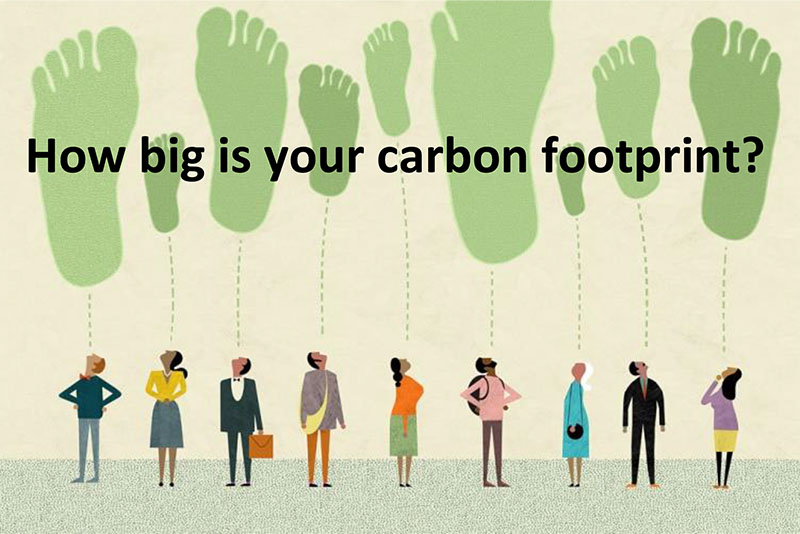Carbon Footprint Certification
Prepare yourself in reducing and controlling emissions monitoring frequently comply with regulations. We are here to help you and to keep the environment safe.
What is carbon Foot print?
A carbon footprint is the total amount of greenhouse gases (including carbon dioxide and methane) that are generated by our actions.
The average carbon footprint for a person in the United States is 16 tons, one of the highest rates in the world. Globally, the average is closer to 4 tons. To have the best chance of avoiding a 2℃ rise in global temperatures, the average global carbon footprint per year needs to drop under 2 tons by 2050.
Lowering individual carbon footprints from 16 tons to 2 tons doesn’t happen overnight! By making small changes to our actions, like eating less meat, taking less connecting flights and line drying our clothes, we can start making a big difference.

How big is your carbon footprint?
A carbon footprint is the amount of greenhouse gases—primarily carbon dioxide—released into the atmosphere by a particular human activity. It is usually measured as tons of CO2 emitted per year, a number that can be supplemented by tons of CO2- equivalent gases, including methane, nitrous oxide, and other greenhouse gases.

Why does your carbon footprint matter?
The most significant challenge of our time, global warming impacts virtually every area of our lives. With increasing temperatures, rising sea levels, extreme weather events, and many other dangers, climate change is a problem that requires each of us to re-think the way we live, work, and move. We can work to reduce the energy consumption, recycle your waste, install solar panels, buy clean energy from your power retailer and thus reduce the carbon footprint in a more sustainable manner.
What are 2 ways industries can improve their carbon footprint?
There are many ways to reduce greenhouse gas emissions from the industrial sector, including energy efficiency, fuel switching, combined heat and power, use of renewable energy, and the more efficient use and recycling of materials.
How can we reduce pollution ?
Setting the air conditioner on 24 degrees or above (61 per cent), recycling or reusing products (61 per cent), washing full loads in the machine or dish washer (58 per cent) and taking shorter showers (56 per cent) are some of the top measures taken by people to reduce pollution around them
What is wrong with the environment?
Our Mother Earth is currently facing a lot of environmental concerns. The environmental problems like global warming, acid rain, air pollution, urban sprawl, waste disposal, ozone layer depletion, water pollution, climate change and many more affect every human, animal, and nation on this planet.
Here are 10 easy ways you can start making a difference:
1. Stop buying your water in plastic. Get a reusable water bottle and keep it filled and with you at all times. You’ll save money and the environment!
2. Incorporate walking or biking to some of your regular short-trip destinations. In most instances, you can walk a mile in less than 20 minutes. This is a great way to add exercise to your busy schedule.
3. Turn off lights and unplug devices when you’re not using them. Every little action adds up!
4. Keep the tires on your car properly inflated and get regular tune-ups. When your car’s tires are low on pressure, it has to work harder to move from point A to point B, wasting gas and increasing emissions in the process.
5. Eat more food that is grown or made locally and less red meat. Taste the difference, feel better and support the Austin economy!
6. Use the cold water cycle for washing your clothes. And do your laundry in FULL loads. This will decrease the amount of water and energy used, helping you save time and money. Bonus points for line-drying – it takes a lot of energy to power your dryer!
7. Set your thermostat to 78 in summer and 67 in winter. And turn-off the heat and AC when you’re not home. You’ll be surprised at the difference it makes in your energy bill.
8. Drive efficiently. Use the accelerator lightly, coast to red lights, stay near the speed limit, and park and go inside instead of idling your engine in a drive-thru.
9. Keep stuff out of the landfill. Sell items you no longer use to thrift shops, have a yard sale, or donate them to charity. Recycle or repurpose everything you can’t get rid of.
10. Use alternative transportation (bus, train, carpool, or bike) to get to work one day per week. Enjoy the chance to catch up on your reading instead of testing your patience in traffic!
Simple actions really add up when everyone joins in! Deciding to take action means that you want to take care of this place we call home – making Austin greener today and for many years to come. Doing your part makes you a Net-Zero Hero!